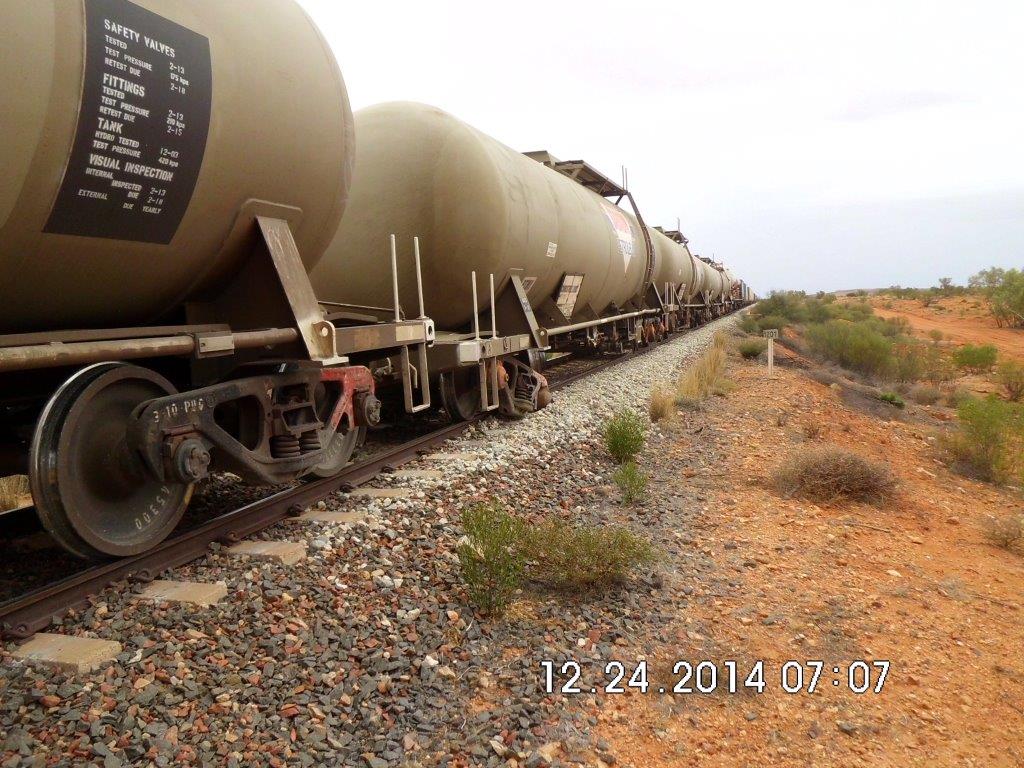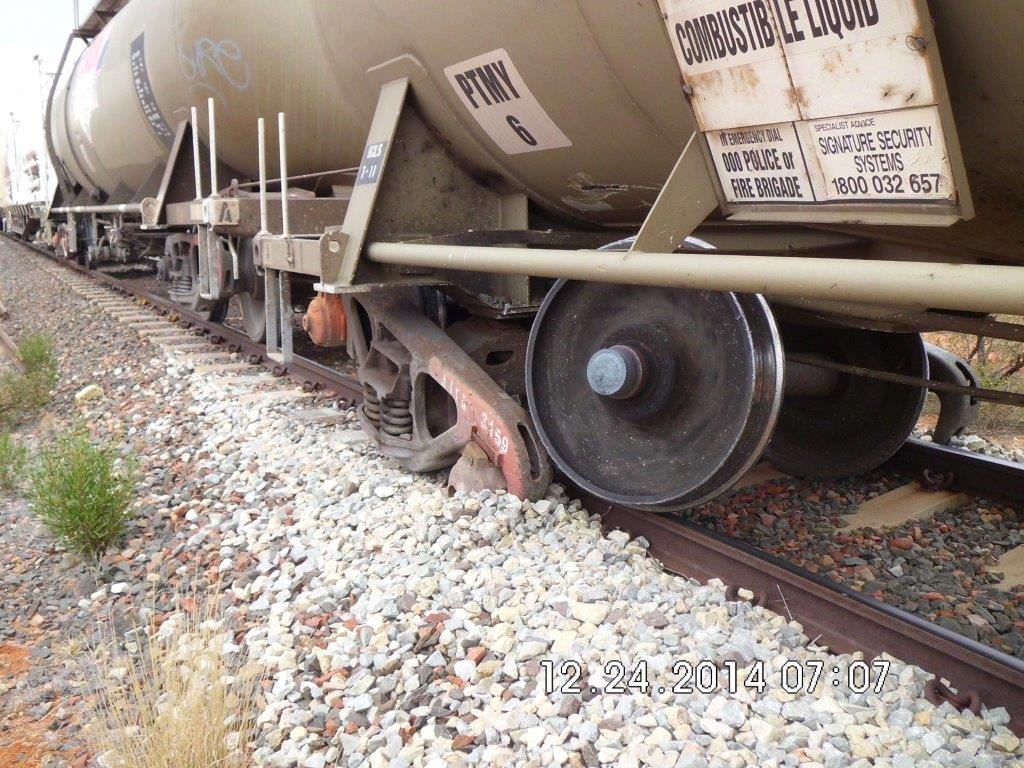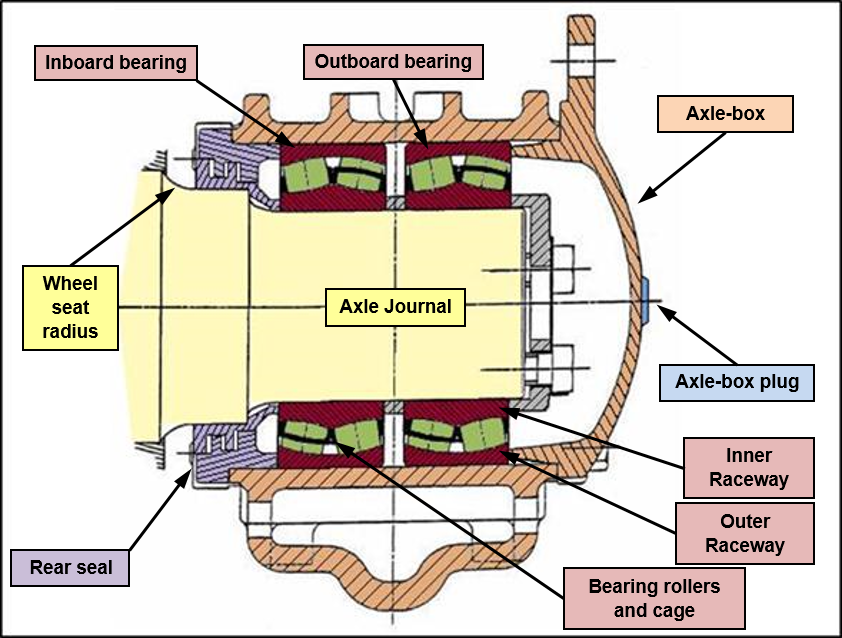Safety summary
What happened
At about 1925 CDT[1] on 23 December 2014, GWA train 2AD1 derailed near Hugh River, Northern Territory. The derailment resulted from an axle bearing failure on wagon PTMY 6-T. The wagon, carrying distillate fuel, remained upright and there was some minor damage to the track (sleepers and rail clips). There were no injuries.
What the ATSB found
The ATSB found that the journal and bearing on wagon PTMY 6-T had seized and lost interference fit – generating high levels of frictional heating between the bearing and axle journal, and the subsequent torsional shearing failure of the axle (a ‘screwed journal’). The axle failure immediately caused the leading axle of the trailing bogie to derail.
On the balance of the available evidence, the ATSB concluded that a loss of lubrication or an internal bearing cage failure was the most likely contributor to the bearing breakdown and seizure. Evidence also suggested the breakdown developed relatively rapidly, given the absence of a positive fault detection from two bearing acoustic monitoring systems (RailBAM®) passed on the day of the occurrence.
Safety message
Bearing failures leading to derailment continue to occur within the Australian rail network. Rail operators must continue to be vigilant and ensure axle bearings, and in particular axle box type bearings, are correctly installed, maintained and monitored throughout their life.
Train 2AD1 near Hugh River, NT

Source: Genesee Wyoming Australia Pty Ltd
__________
At about 0123[2] on 23 December 2014, Genesee & Wyoming Australia Pty Ltd (GWA) train 2AD1 passed through a RailBAM®[3] sensor unit at Nectar Brook, SA without incident. Later that day 2AD1 passed through another RailBAM® site at Northgate, SA which, once again, did not record any adverse detections within the train consist.
Approximately 690 km past Northgate, the driver of 2AD1 noticed a reduction of brake pipe pressure and a subsequent automatic application of the train brakes. The crew then noticed a large amount of dust towards the rear of the train. Train 2AD1 was brought to a stand and the crew carried out an inspection of the train consist.
The crew found that wagon PTMY 6-T (distillate tank wagon) had derailed, with the leading axle of the trailing bogie completely separated from the right hand side axle box in a manner commonly known as a screwed journal (Figure 1). The bogie had collapsed and some minor damage had occurred to the body of the wagon. The derailment caused about 1,800 m of track damage – mostly cracked concrete sleepers and damage to rail fastenings. There was no spillage of distillate from the wagon.
Figure 1: Wagon PTMY 6-T derailed at 1201km

Source: Genesee Wyoming Australia Pty Ltd
The train crew contacted the GWA Network Controller around 1935 and advised them of the incident.
The following day, track and maintenance crews attended the derailment site. The distillate was decanted from PTMY 6-T and the wagon removed from track. At around 1245 on 24 December 2014, train 2AD1 continued towards Alice Springs, arriving at 1640.
__________
Train information
Train 2AD1 was an intermodal freight service operated by Genesee & Wyoming Australia (GWA) between Adelaide and Darwin. On departure from Spencer Junction, Port Augusta SA, the train consisted of locomotives GWU 2 (leading) and ALF 18 (trailing) hauling 42 wagons for a total length of 1,496 m and gross mass of 3,684 t.
The 12th wagon in the consist was PTMY 6-T, a bogie tank wagon used to transport distillate fuels. The PTMY class wagons are rated at 26 t (tare), 76 t (gross) and operate at a maximum speed of 115 km/h. The wagons ride on three piece “Super ride control” bogies. Sabadin Petroleum (a subsidiary of Caltex Australia) owned the tank wagons, with maintenance contracted to Downer Rail.
At the time of the derailment PTMY 6-T weighed 73.4 t and the train was travelling at approximately 90 km/h.
Bearing examination
The bearings on wagon PTMY 6-T were of an axle box type, each axle box housing two spherical rolling element bearings (Figure 2).
Figure 2: Axle Box Bearing components

Schematic illustrating the components of an axle box bearing. Source: AS/RISSB 7516 Railway Rolling Stock - Axle Bearings coloured and annotated by ATSB
It was evident that a bearing on the wagon had failed and completely seized, causing the inner raceway to loose interference fit and spin on the axle journal. This generated and transferred sufficient heat into to the journal to reduce its strength, make it ‘plastic’ and cause it to torsionally separate from the axle (an event commonly referred to as a screwed journal).
Post-derailment observations found that the axle box lubrication plug was missing. Neither the plug, rear seal nor the stub end of the journal were found.
Bearing examination
GWA forwarded the recovered axle box components to Bureau Veritas for metallurgical examination.
The inboard bearing was manufactured by SKF (Sweden) and showed evidence of significant heat damage. The inboard bearing cage was manufactured from a bronze alloy and appeared to have been completely melted. There was no evidence of brinelling (impact), or spalling (flaking) damage to the rolling surfaces. The outboard bearing was manufactured by Koyo (Japan) and also showed evidence of significant heat damage. The steel cage was heavily deformed. There was no evidence of brinelling or spalling damage to the rolling surfaces of either bearing.
The investigation also examined the partner bearing from the opposite end of the axle. This bearing was found in good order, however the inboard bearing unit had significantly less grease present, when compared to the outboard unit.
Bearing failure
The failure process resulted in complete destruction of the bearing and much of the evidence that may have identified the cause of the failure. Consequently, the investigation looked at the common failure modes for railway bearings to identify the most probable cause.
The main contributors to rolling-stock axle bearing failure are:
- Rolling surface damage
Rolling surface damage (spalling) is a contact-fatigue mechanism and can result from lubrication supply or effectiveness issues, contaminants carried in the lubricant, or indentations due to impact loading. Spalling is where the bearing surfaces or rollers begin to break up, or flake. The material that has broken away then moves around inside the bearing, causing further damage to the rolling surfaces.
- Component failure
A common cause of bearing failure is failure of the cage. The cage maintains the roller bearings in the correct spacing and alignment. If the cage loses its ability to correctly align and guide the rollers, the resultant forces can lead to rapid deterioration and break-up of the cage. Under these conditions, broken cage material may become jammed in the rolling surfaces, with bearing seizure the likely result.
- Lack of (or faulty) lubrication
The purpose of a lubricant is to reduce friction by separating the rolling surfaces at the points of high-pressure contact. Contamination of the lubricant by foreign materials such as metal flakes, filings and dirt reduces the effectiveness of the lubricant, and often causes accelerated wear of the components. A lack (or loss) of lubricant, through failed seals or poor maintenance, can result in elevated levels of frictional heating at the contact surfaces – leading to the eventual overheating of the bearing. This can cause components within the bearing to fail, such as the roller bearing cage.
The metallurgical examination found no evidence of rolling surface damage and concluded that the most likely contributor to the bearing failure was a lubrication supply issue. This may have been due to either seal failure or loss of the axle plug. While post-incident observation noted that the axle plug was missing, it could not be determined if the plug had dislodged prior the bearing failure, or because the bearing housing had dragged along the ballast after the journal separated from the axle. The axle box seal was not recovered so could not be examined to determine its condition and the possibility that it may have failed prior to the derailment. Failure of the bronze cage may have also contributed to the failure of the bearing, however the cage had completely melted away so this mode of failure could not be confirmed.
Maintenance
The Australian Rail Industry Safety and Standards Board (RISSB) is responsible for the development and management of rail industry standards, rules, codes of practice and guidelines, all of which have national application. Australian Standard AS7516 Railway Rolling Stock - Axle Bearings – Part 2: Freight Rolling Stock covers the maintenance of the various types of bearings used in the Australian railway industry, including axle box type bearings.
Section 4.1 of AS7516-2 requires operators to have in place a system for determining when re-lubrication of axle bearings is required. To assist maintenance personnel in identifying bearings requiring re-lubrication, Section 4.3 requires operators to paint the axle box covers in accordance with a nationally-recognised colour coding.
GWA maintenance instructions[4] require wagons with axle box bearings to have the bearings regreased every 2 calendar years, with a period of grace extending up to April 1 the following year. Maintenance of GWA’s rolling stock running gear[5] had been contracted to Downer Rail until June 2014, and has since been conducted in-house by GWA directly.
Records show the axle bearings on wagon PTMY 6-T received scheduled programmed maintenance on 13 December 2012. The axle box bearings were examined, lubricated, and the axle box plug seals replaced. In accordance with AS7516.2 Section 4.3, the axle box covers were painted orange, indicating the next service was due in 2014.
Wagon PMTY 6-T had travelled just over 100,000 km since servicing and had not exceeded the maintenance timeframes permitted in the instructions. The evidence suggests that the bearings on wagon PTMY 6-T had been adequately maintained in accordance with AS7516.2 and GWA instructions.
Preventative monitoring
The RailBAM® system is a predictive bearing condition monitoring system used throughout Australia. The system listens for unique acoustic signatures known to be associated with specific defect conditions in bearings, such as rolling surface faults and looseness / fretting faults.
Rather than identifying imminent failure of a component, RailBAM® facilitates the potential identification of defects as they develop. This is achieved through analysis of acoustic signature data and the identification of data trends from multiple passes. Rail vehicle operators may use this information for ongoing monitoring and/or scheduling for servicing and repairs.
RailBAM has proved reliable at detecting the acoustic signatures of developing surface faults such as spalling damage. However, it has proved more difficult to detect an acoustic signature that would suggest loss of lubrication.[6]
Train 2AD1 travelled past two RailBAM® sensor sites on 23 December; one at Nectar Brook and the second at Northgate. Neither RailBAM® site detected any potential faults with the bearings on wagon PTMY 6-T. Similarly, there was no historical evidence for wagon PTMY 6-T to suggest a developing trend towards a potential bearing failure.
The absence of indicative acoustic signatures on the day of the bearing failure suggests that the bearing condition on wagon PTMY 6-T deteriorated relatively quickly, resulting in catastrophic failure of the bearing with minimal (if any) warning signs.
Previous occurrences
In September 2008, a freight train derailed at Mt Christie, SA. The investigation found a bearing on wagon VQCY 0824U had failed, causing a loss of interference fit and a subsequent screwed journal. The damage to the railway infrastructure resulted in 13 wagons derailing.
Examination of the bearings suggested that inadequate lubrication had contributed to cage failure with the subsequent misalignment of the rollers and jamming of broken cage material in the rolling surfaces causing the bearing to seize[7].
In October 2010, 15 wagons on freight train 3PW4 derailed near Wodonga, Victoria. There were no injuries, however serious damage to rolling-stock and rail track (including a bridge structure) was sustained during the derailment.
The investigation concluded that an axle bearing on wagon RKWY-4125C had failed and completely seized, causing the inner rings to spin on the axle journal, generating and transmitting sufficient heat into to the journal to make it 'plastic' and causing it to separate from the axle[8].
In each case, there were limited pre-cursor warning signs of imminent bearing failure.
__________
- GWA Wagon Maintenance Instruction RO-WMI 05-01, Bearing Maintenance
- Industry term used to collectively describe the wheels, bogies, brake components and associated equipment other than the body of a wagon.
- Southern,C., Rennison,D & Kopke,U (2004). RailBAM® - An advanced bearing acoustic monitor – initial operational results RTSA – Conference on Railway Engineering,
- ATSB Transport Safety Report, Rail Occurrence Investigation RO-2008-010.
- ATSB Transport Safety Report, Rail Occurrence Investigation RO-2010-011.
From the evidence available, the following findings are made with respect to the derailment of train 2AD1 near Hugh River on 23 December 2014. These findings should not be read as apportioning blame or liability to any particular organisation or individual.
Safety issues, or system problems, are highlighted in bold to emphasise their importance. A safety issue is an event or condition that increases safety risk and (a) can reasonably be regarded as having the potential to adversely affect the safety of future operations, and (b) is a characteristic of an organisation or a system, rather than a characteristic of a specific individual, or characteristic of an operating environment at a specific point in time.
Contributing factors
- An axle bearing on PTMY 6-T failed and completely seized, causing the bearing journal to separate from the axle.
- The most likely cause of bearing failure was a lack of lubrication and/or a short-term breakdown and failure of the bearing cage.
- The bearing condition probably deteriorated relatively quickly, resulting in catastrophic failure of the bearing with minimal (if any) warning signs.
Other findings
- The axle bearings on PTMY 6-T had been maintained in accordance with GWA and rail industry standards.
Sources of information
The sources of information during the investigation included:
- Genesee & Wyoming Australia (GWA)
- The Australian Rail Track Corporation (ARTC)
- Downer Rail
References
ATSB Transport Safety Report, Rail Occurrence Investigation RO-2008-010
ATSB Transport Safety Report, Rail Occurrence Investigation RO-2010-011
SKF, Product Information 401, Bearing failures and their causes 1994
Bureau Veritas, Bearing Report Rev 3, 1 April 2015
Submissions
Under Part 4, Division 2 (Investigation Reports), Section 26 of the Transport Safety Investigation Act 2003 (the Act), the Australian Transport Safety Bureau (ATSB) may provide a draft report, on a confidential basis, to any person whom the ATSB considers appropriate. Section 26 (1) (a) of the Act allows a person receiving a draft report to make submissions to the ATSB about the draft report.
A draft of this report was provided to Genesee Wyoming Australia, the drivers of train 2AD1 and the Office of the National Rail Safety Regulator.
Submissions were received from Genesee Wyoming Australia and the Office of the National Rail Safety Regulator. The submissions were reviewed and where considered appropriate, the text of the report was amended accordingly.
Purpose of safety investigationsThe objective of a safety investigation is to enhance transport safety. This is done through:
It is not a function of the ATSB to apportion blame or provide a means for determining liability. At the same time, an investigation report must include factual material of sufficient weight to support the analysis and findings. At all times the ATSB endeavours to balance the use of material that could imply adverse comment with the need to properly explain what happened, and why, in a fair and unbiased manner. The ATSB does not investigate for the purpose of taking administrative, regulatory or criminal action. TerminologyAn explanation of terminology used in ATSB investigation reports is available here. This includes terms such as occurrence, contributing factor, other factor that increased risk, and safety issue. Publishing informationReleased in accordance with section 25 of the Transport Safety Investigation Act 2003 Published by: Australian Transport Safety Bureau © Commonwealth of Australia 2015
Ownership of intellectual property rights in this publication Unless otherwise noted, copyright (and any other intellectual property rights, if any) in this report publication is owned by the Commonwealth of Australia. Creative Commons licence With the exception of the Coat of Arms, ATSB logo, and photos and graphics in which a third party holds copyright, this publication is licensed under a Creative Commons Attribution 3.0 Australia licence. Creative Commons Attribution 3.0 Australia Licence is a standard form licence agreement that allows you to copy, distribute, transmit and adapt this publication provided that you attribute the work. The ATSB’s preference is that you attribute this publication (and any material sourced from it) using the following wording: Source: Australian Transport Safety Bureau Copyright in material obtained from other agencies, private individuals or organisations, belongs to those agencies, individuals or organisations. Where you wish to use their material, you will need to contact them directly. |
Whether or not the ATSB identifies safety issues in the course of an investigation, relevant organisations may proactively initiate safety action in order to reduce their safety risk. The ATSB has been advised of the following proactive safety action in response to this occurrence.
Genesee Wyoming Australia
GWA have investigated and implemented the following actions:
- A grease nipple will be added to all axle boxes. This would ensure both the inner and outer bearings receive a more even distribution of grease when axle boxes are regreased during scheduled servicing.
- Bearings incorporating bronze cages will be progressively withdrawn from service and replaced with new steel-cage bearings.
- The GWA Work Instructions associated with bearing overhaul and preventative maintenance/ inspection have been reviewed and updated to reflect the process changes.
- The updated Work Instructions have been disseminated to all affected GWA rolling stock maintenance staff, and contracted bearing suppliers and maintainers.


